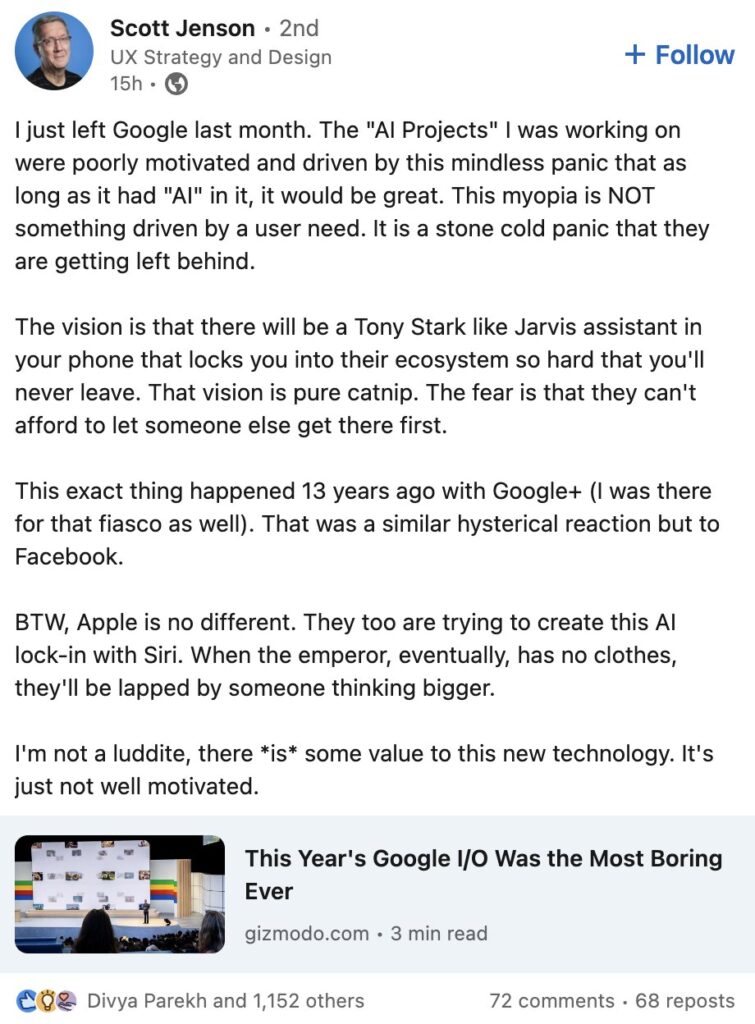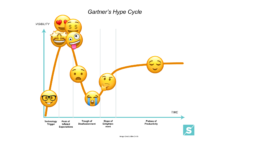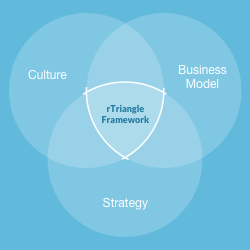The Common Mistakes of Hype Cycle Reactionism
As we move through the hyper hype cycle of AI, it reminds me of another monumental hype cycle triggered by the launch of the original iPhone and subsequently the App Store. Much like AI today, the iPhone coupled with the App Store ignited an economic and social transformation. At the time, I was working on Qualcomm’s mobile commerce strategy, where I had the opportunity to conduct extensive mobile strategy discovery with some of the largest retailers and CPGs. It was evident that the mobile app hype was driving companies to prioritize expediency over planning, research, and testing. Furthermore, these companies were basing major strategic decisions on the wrong determinants, driven by the following motivations:
- Branding: Leadership teams were tantalized by mockups showing their logo/app icon on the deck of an iPhone. Brand exposure and association with the iPhone were paramount, while customer value and sustainable engagement became afterthoughts.
- Strategic Urgency: Driven by a lack of preparedness and fear of missing out, company leadership teams were under tremendous pressure to not only develop a mobile app strategy but to quickly commence execution.
- Unrealistic Expectations: Due to the hype cycle, customers, employees, and decision-makers were witnessing the success stories (e.g., Starbucks app) and expecting similar outcomes for any and all mobile offerings.
Not surprisingly, many app launches failed to provide users value and struggled with both acquisition and retention. Without the right motivators and strategic planning, these failures were almost inevitable. Yet over time, with learnings and better planning, these same companies have developed mobile apps that provide user and business value.
With today’s AI hype cycle, many of the same motivators and determinants are prevalent. Even the best-run tech companies are repeating these mistakes. Here’s a post (formerly known as a tweet) that is a case in point:

To avoid these traps, executives should initially focus on discovery and research across these critical dimensions:
- Protection of Assets: First and foremost, companies should ensure their IP, data, content, and copyrighted materials are not being consumed by Large Language Models.
- Competitive Analysis: Secondly, it’s important to thoroughly analyze how AI will disrupt and impact your market(s). It’s very likely that AI-based companies will use the technology to gain a competitive advantage over your offerings. It’s critical to identify threats from incumbents, newcomers, and players in adjacent markets. This analysis should include high-level views of disruptive use cases, workflows, and product offerings.
- Productivity: The productivity gains we’re seeing today via AI are only the beginning. The extent of the productivity gains is unknown, but it’s within the realm of possibility that AI will drive the largest increase in productivity in human history. There are countless opportunities to augment existing operations with AI, regardless of company or industry. It’s imperative to dedicate resources to identify these operational strategies. If well executed, companies will see productivity gains while developing their employees' AI skillsets.
- Customer Service: Adopt AI-enabled CS systems to augment and improve customer service teams. When implemented correctly, AI-enabled CS solutions will increase availability, coverage, reduce costs, and improve customer satisfaction.
- Commercialization of AI: For most companies, developing AI products and/or commercializing AI should be lower in priority than protecting assets, competitive analysis, productivity, and customer service. As with any major product initiative, taking a smart route requires the right mix of planning, alignment, resources, budget, and sustainable urgency. As those who've worked with me know, one of my favorite sayings is: it’s better to measure twice and cut once. Take the time to identify opportunities, ideate, and most importantly, talk to your customers
By learning from past mistakes and focusing on these dimensions, companies can navigate the AI hype cycle more effectively and achieve sustainable success by providing customer value.
Introducing The rTriangle Framework
I've spent the majority of my career working on strategic initiatives for companies big and small. During that time, I've managed my share of strategic plans, product roadmaps, and outcome-driven systems. The last is a better approach to get teams to think beyond goals and outputs. However, even the best implemented outcome-driven strategies fail to achieve the majority of the very outcomes they're designed to produce. While there's a confluence of reasons that contribute to undesirable outcomes and failed strategies, an often overlooked factor is the interdependencies of organization culture, business modeling, and strategy.
For the past few years I've been developing and experimenting with a modified outcome-driven framework that accounts for these strategic interdependencies. This article is a very high-level introduction to this framework and its primary concepts. I'll be publishing deeper dives in the weeks and months ahead.
Overview
The rTriangle Framework is a holistic approach to strategy that combines elements of organizational culture, business modeling, objective setting, strategic planning, and continuous improvement. It's an outcome-driven strategy that enables teams to proactively maximize the business value of outcomes while staying focused on sustainable strategies that develop competitive advantages. The rTriangle framework has been designed for early- and growth-stage tech companies, but can be molded to suit any business.The rTriangle Framework is divided into two primary categories: Objectives and Outcomes. Objectives lead to clarity, focus, and alignment on company goals. Whereas Outcomes form the processes for creating and measuring outputs that subsequently inform future Objectives.
Objectives
The Objectives category is made up of five components that establish collective direction, organizational alignment, business modeling, execution, and criteria for generating meaningful value.
Shared Direction (objective #1)
The Shared Direction component serves as the inspirational definition of a company’s reason for being and sets the direction for the entire organization. A key benefit of a well-executed strategy is how it drives alignment across a company. With the rTriangle Framework, alignment begins with having a Shared Direction that spans from near to long term.
Focal Point (objective #2)
The Focal Point component drives a singular approach to business modeling and operational culture that aims to maximize a company strengths and market differentiation.
The Focal Point component is designed to address the issue of strategic interdependence by aligning a company’s business model, organizational culture, and value system to the Shared Direction. In addition to optimizing alignment across these dependent dimensions, the Focal Point component provides a simple blueprint of how an organization should be designed and where resources should be concentrated.
Strategy (objective #3)
The Strategy component is where the framework begins to transition from long-term directional and organizational concepts to more tactical strategic concepts. The aim of the Strategy component is to identify the imperatives that have the potential to create the most businessvalue and then to assign cross-functional resources on those impertivies. Strategy is not a one-size-fits-all concept and the secondary components to Strategy are designed to support strategies of all shapes and sizes.
In conjunction with near-term strategic initiatives, the framework does encourage a long game approach to establishing sustainable competitive advantages by creating Competitive Leverage (a moat).
Projects & Roadmap (objective #4)
The Projects & Roadmap component is where execution begins. At this stage, teams are responsible for generative research, scoping, shaping, and prioritizing projects. The generative research and prioritization process should take a data informed approach that produces a mix of small and large bets.
Traditional project management product roadmapping, collaboration processes, and prioritization methodologies may run in conjunction with this component. However, your product design and project management processes should be aligned with the business model set forth in the Focal Point component.
Value Criteria (objective #5)
The Value Criteria component is the final Objective-based component and defines the success criteria for projects and product enhancements that must be value based.
The framework puts forward a value-based approach to defining success criteria and discourages the use of vanity metrics that don’t drive value for your users or business.
Outcomes
At this point, the framework transitions from Objectives to Outcomes. The Outcomes category is made up of two outcome-based components that includes Outputs and their associated Indicators (measured results).
 Outputs (outcome #1)
Outputs (outcome #1)
The Outputs component captures all business and product Outputs that are released and ready to be measured against predefined indicators and Value Criteria.
The outcome-driven approach of the framework discourages teams from considering outputs as an ending point. Rather, Outputs should be viewed as a means to an end. They're the first step in the measuring and learning phase and teams must own the Outcomes in addition to the Outputs.
Indicators (outcome #2)
The Indicators component is the business and technical processes to measure Outputs by tracking the value created by released projects and product enhancements.
Again, the framework puts forward a value-based approach to defining and measuring success criteria. Measure the metrics that matter and commit to understanding the contributing factors to the differences between what was expected and what actually occurred.
Continuous Improvement
Similarly to lean methodologies and continuous improvement (build, measure, learn, adapt), the rTriangle Framework is a cyclical strategy where Outcomes inform the Strategy, Projects & Roadmap, and Value Criteria components.
Although the framework aims to develop a culture of learning and adapting, it's important to note that Shared Direction and Focal Point are long-term concepts that should be immutable. Altering the collective direction, business model, and/or the organizational alignment of a company should only be done as part of major transformation or pivot.
The cycle nature of the strategy promotes a customer/user centric philosophy that delivers improved quality of the end product/service and creates more value for all stakeholders.
Summary
The rTriangle Framework is an outcome-driven strategy that enables teams to proactively maximize the business value of outcomes while staying focused on sustainable strategies that develop competitive advantages. The benefits derived from this framework are achieved via a wholistic alignment of organizational culture, business modeling, and strategy. Well-aligned companies can begin to reach new heights by enabling an environment of highly autonomous and cross-functional teams that continually drive better Outcomes.
There’s a significant amount of framework context and component details that I’ve commenced documenting - more to come.

